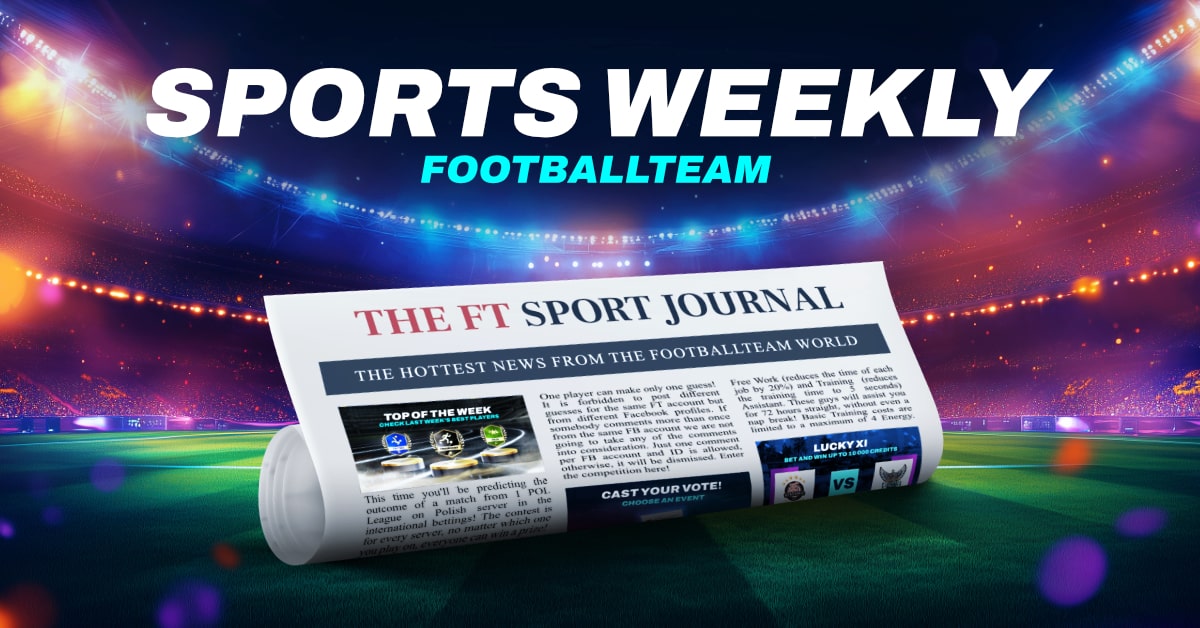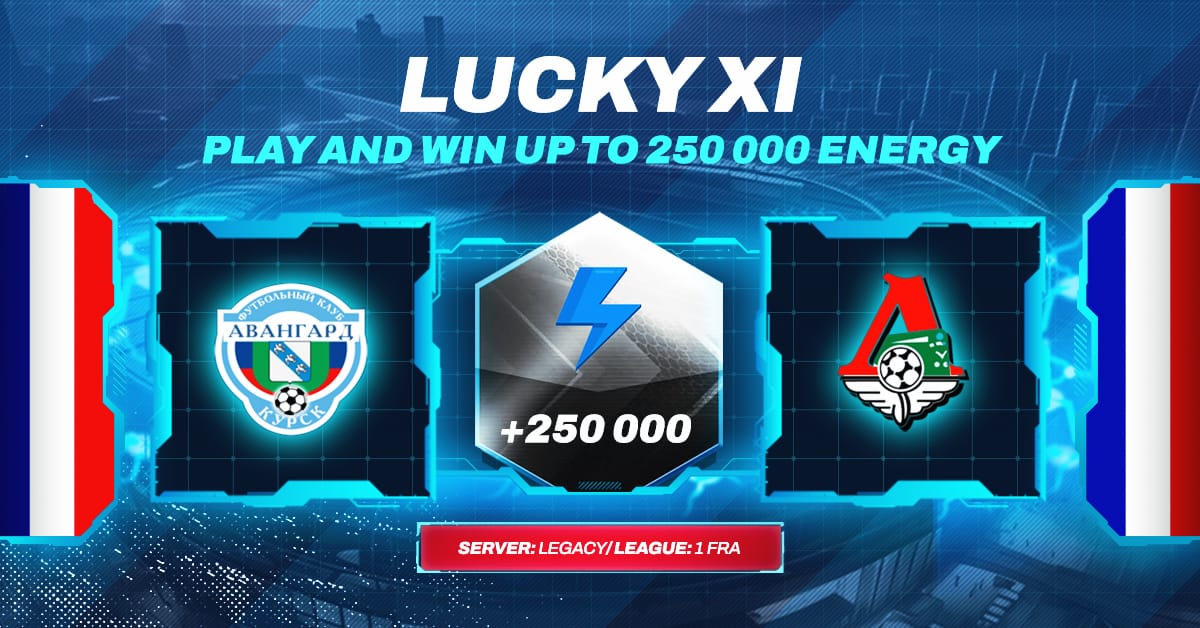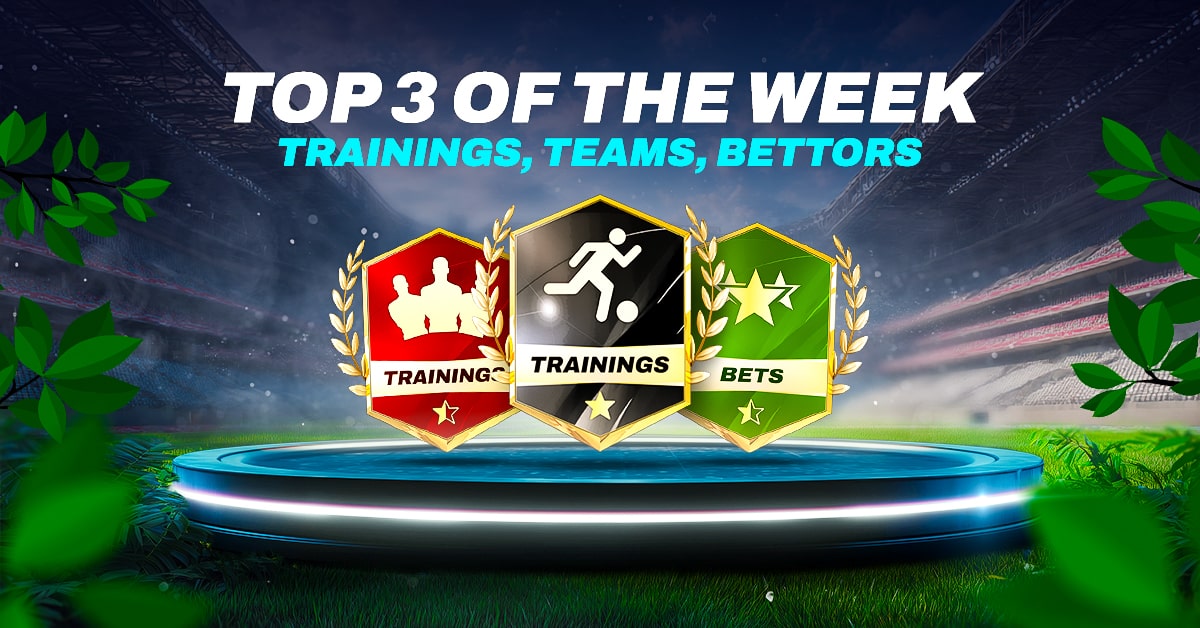The FT Sport Journal Legacy #9
25-09-2024




Your weekly source of information and entertainment, Sports Journal on server Legacy #9 brought to you by our journalists, is here! Remember to vote for your favorite article at the end! ☕
TABLE OF CONTENTS
1/ PROJECT OF THE STARTING MICROCYCLE STRUCTURE
2/ CLUB LOYALTY IN FOOTBALL AND FOOTBALLTEAM
3/ FEMALE REFEREES: BREAKING BARRIERS
4/ THE EVOLUTION OF GOALKEEPER GLOVES
5/ NEW CHAMPIONS LEAGUE. IS IT BETTER OR WORSE?
PROJECT OF THE STARTING MICROCYCLE STRUCTURE
Welcome to the second part of my article on the preparation period for football teams. Today, we'll discuss the starting microcycle, which consists of training units designed to prepare our team for league competition.
Table 1: The structure of a one-year macrocycle with a division into two starting periods and the specified duration of preparatory periods 1 and 2.
Legend used in the table:
🔹M1 to M30 – league matches (official matches)
🔹Mi-1 to Mi-16 – training microcycles
🔹MK – scheduled control matches (friendlies)
🔹Purple color – represents the first and second starting periods
🔹White color – transition period after completed rounds
🔹Blue color – first preparatory period
🔹Orange color – second preparatory period
🔹Red color – BPS (Direct Starting Preparation Period)
First Preparatory Period
The preparatory period starts on July 5, 2024 (Monday) and consists of 6 microcycles. Each of them lasts 4 days - Tuesday, Wednesday, Friday - and ends with a control match on Saturday. The 6th microcycle in this preparatory period before the autumn round is also the direct starting preparation period (BPS). Each microcycle includes 1 training session per day. Training sessions always take place in the afternoon due to the work schedules of most players. On Tuesdays, Wednesdays, and Fridays, the training sessions are held on a grass field, and on Saturdays, there is a control match.
Duration: 6 microcycles
Microcycle: Each microcycle lasts 4 days: Tuesday, Wednesday, Friday, ending with a control match on Saturday.
🔹Tuesday: Training on a grass field
🔹Wednesday: Training on a grass field
🔹Friday: Training on a grass field
🔹Saturday: Control match (friendly)
Characteristics:
🔹Training sessions are held in the afternoons, tailored to the schedules of players who work during the day.
🔹The 6th microcycle is also the direct starting preparation period (BPS), which is crucial before the autumn round.
Second Preparatory Period
The second preparatory period begins on January 10, 2025 (Monday) and consists of 10 microcycles. Each microcycle lasts 4 days - Tuesday, Wednesday, Friday - and ends with a friendly match on Saturday. The 10th microcycle in this period before the spring round is also the direct starting preparation period (BPS). As in the first preparatory period, each microcycle includes 1 training session per day in the afternoon due to the players' work schedules. Training sessions are held on a grass field on Tuesdays, Wednesdays, and Fridays, with a control match on Saturday. After the direct starting preparation period, the first league match of the return round will take place, aiming to achieve the goal of securing a spot in the league.
Preparatory Period 2 (Winter)
🔹Start: January 10, 2025 (Monday)
🔹Duration: 10 microcycles
🔹Microcycle: Each microcycle lasts 4 days: Tuesday, Wednesday, Friday, ending with a friendly match on Saturday.
- Tuesday: Training on a grass field
- Wednesday: Training on a grass field
- Friday: Training on a grass field
- Saturday: Control match (friendly)
Characteristics:
🔹 As in the first preparatory period, training sessions are held in the afternoons, tailored to the players' schedules.
🔹 The 10th microcycle in this period is also the direct starting preparation period (BPS), which is crucial before the spring round.
Final Remarks
🔹Microcycles: Each microcycle is carefully planned to maximize the effectiveness of training and preparation for matches.
🔹Adaptation to Conditions: All training sessions and matches are adapted to the available conditions, including the playing surface and the players' schedules.
🔹The macrocycle has been planned in a way that aims to optimize preparation while effectively managing the players' workload at different stages of the season, which should lead to achieving the intended sports goals.
Thank you for reading my article! If you enjoy this topic or have an idea about what I could write about next, feel free to leave your suggestions in the comments. Cheers!
Author: Kiero DS
CLUB LOYALTY IN FOOTBALL AND FOOTBALLTEAM
Club loyalty in football refers to players' commitment to a single club over an extended period (often throughout their entire career), which, in today’s game dominated by transfers, big money, and squad rotations, has become increasingly rare. Nowadays, a player doesn’t need to spend their whole career at one club to become a legend, but such players are exceptions. It’s sometimes difficult to balance loyalty to the club you play for and have supported since childhood when faced with offers involving much higher financial rewards. Loyalty to a club, often called “love for the club colors,” includes both emotional and professional ties to a club, sometimes for a whole career or the majority of it.
Examples:
Players who first come to mind in the context of club loyalty are legends like Paolo Maldini from AC Milan, Francesco Totti from AS Roma, and Ryan Giggs from Manchester United. Their entire careers, spent at one club, made them immortal symbols of loyalty in football. It's also worth mentioning Steven Gerrard, who, although he ended his playing days at Los Angeles Galaxy, it was more of a symbolic step linked to football retirement. His true loyalty was always to Liverpool, where he later began his managerial career, coaching the club's youth teams.
Lionel Messi can also be included in this group, having spent over 20 years at Barcelona. Although he ultimately had to leave the club, this was primarily due to absurd financial restrictions imposed by Javier Tebas, the president of La Liga. The decision to prevent Messi from continuing his career at Barcelona quickly proved to be a mistake, and La Liga has significantly declined in sporting quality. It's hardly surprising when you "kick out" the best footballer in history.
FootballTeam:
However, things work a little differently in FootballTeam compared to reality. In FT, a club can collapse overnight, and during the frantic transfer windows, mergers between clubs often occur. A prime example of this is Team Activity, which once again saved itself from dissolution through a merger. In such cases, loyalty and dedication to the club are difficult to maintain; you never know if this will be the last season for the club or for you, as a merger might see you lose your spot on the team. Therefore, if you're looking for a club where values such as loyalty, dedication to club colors, or a friendly atmosphere and environment are important, I recommend clubs that have proven they can survive despite many challenges and upheavals, which are extremely common in the FT world. For those interested, here’s a list:
These are teams from the TOP 30 that fit the above criteria. There's no Russian team on the list as I don't know any, so I won't comment on them.
Additionally, I would like to point out that mergers are not inherently bad, but they need to be done wisely, without harming loyal players or destroying the club’s atmosphere just to gain a few extra overall points in the club rankings. This is a game where the atmosphere within the club should take precedence over chasing "numbers." In my career, I represented two clubs. The first was Czarne Oczy, where after winning the first league, we decided that we had reached our peak, and it was the right time to end the club's story, without holding back or keeping people who wanted to retire from FT. The second club was, of course, Dream State, where even now I still keep in touch with many people, and some of us even play together on the global server as Emeryci. As you can see, focusing on the team atmosphere, often at the expense of fewer or limited transfers, paid off. So, if you have a team with potential, where you have a great time together, your time may come too!
That’s all for today. Feel free to share your thoughts in the comments. I'm sure a few people will have complaints about why their club wasn't mentioned or why a particular club that they think shouldn't be here is. I've been playing FT since Season 13, and I selected clubs that I know well and have seen how long they’ve been playing. The exception is WIZARD, as they are the "youngest" of them all (some clubs previously played under different names), but WIZARD’s have proven that they have a tight-knit team, and although I didn’t always get along with everyone there in the past, I objectively believe they deserve recognition.
If anyone wants to discuss this article (or any other topic) directly with me, feel free to join the FT Discord. Have a great day and see you next week!
Author: Bestia
FEMALE REFEREES: BREAKING BARRIERS
Female referees in football have been gaining more and more prominence and recognition in recent years, demonstrating that the ability to referee a football match is not restricted to one gender.
The First Steps:
Early 20th Century: The first women to act as referees appeared in the early 20th century, in sports such as basketball and softball, in the United States. However, their careers were often marked by resistance and lack of opportunities.
Football: In football, the female presence in refereeing began timidly and gradually. The first female football referees faced even more challenges, due to the traditionally male nature of the sport.
Challenges faced by female referees:
Prejudice and discrimination: Female referees still face prejudice and discrimination, both from players, coaches, managers and fans.
Lack of opportunities: Historically, women have had fewer opportunities to develop in their refereeing careers, which makes it difficult for them to advance.
Visibility: The media still dedicates little space to coverage of female referees, which limits the visibility of female referees and makes it difficult to recognize their work.
Progress and achievements:
Increase in the number of female referees: More and more women are entering the refereeing career and reaching prominent positions in national and international competitions.
Recognition from federations: Football federations have implemented policies to promote gender equality in refereeing, offering courses and development opportunities for female referees.
Presence in major competitions: Female referees are already present in major competitions, such as the Women's World Cup and the Champions League.
The Future of Female Referees:
The future of female referees is promising. With the increase in awareness about the importance of gender equality in sport, the presence of female referees tends to become increasingly consolidated. The new generations of female referees will have more opportunities, more visibility and a more inclusive environment to develop their careers.
The pioneer
Asaléa Campos Michelli: The first woman to referee football in Brazil and in the world.
Some of the greatest matches refereed by women:
Finding an exhaustive list of all the great matches refereed by women throughout history is a challenge, as the coverage is not always extensive and detailed. However, we can highlight some historical moments:
Stephanie Frappart: Frenchwoman Stephanie Frappart became one of the most well-known referees when she refereed the 2019 UEFA Super Cup final between Liverpool and Chelsea. This was the first time a woman refereed a final in a European club competition.
Edina Alves Batista: Brazilian Edina Alves Batista was the first woman to referee a match in the Série A of the Brazilian Championship. She has also participated in several Women's World Cups and other international tournaments.
Stéphanie Labbé: Canadian Stéphanie Labbé, besides being a former professional goalkeeper, has also worked as a referee and assistant referee in several competitions.
Kateryna Monzul: Ukrainian Kateryna Monzul was the first woman to referee a UEFA Champions League match.
Thank you and see you next time!
Author: Fabio Muri
THE EVOLUTION OF GOALKEEPER GLOVES
Goalkeeper gloves have always been an essential item in a goalkeeper's equipment, like all football accessories, they have undergone a long journey of evolution from their simple origins to the advanced technologies present in today's models. Let's understand the history and discover how these accessories became so important for the safety and performance of goalkeepers.
The First Steps
19th Century: The first goalkeeper gloves appeared in the 19th century, with very rudimentary designs. They were, in most cases, leather gloves with little protection and grip.
1920s
Early 20th Century: From the 1920s onwards, gloves began to gain more prominence, with the inclusion of materials such as rubber to improve grip on the ball.
The Golden Decade: 1970s
Popularization: The 1970s were a milestone in the history of gloves. They became more popular and the desire for a more specific accessory increased greatly.
New brands: Many glove brands emerged, such as Stanno, Sondico, Reusch, Uhlsport, Adidas, Nike, Reebok and Penalty.
The Quest for Perfection: The 1980s and 1990s
Innovation:From the 1980s onwards, gloves became a fundamental part of goalkeeper equipment. Manufacturers began to research other types of designs, particularly in terms of friction and ball control.
New materials: They experimented with terry cloth, the covering of table tennis rackets and latex foam.
Personalisation: Personalisation of gloves also became a trend, with the possibility of adding names and numbers.
The Modern Era: The 21st Century
Cutting-edge technology: Goalkeeper gloves became true works of engineering, with the use of high-tech materials such as natural and synthetic latex, memory foam and ergonomic cuts.
Specific models: Specific models have emerged for different types of weather and game conditions, such as gloves for dry weather, wet weather and even for night games.
Design: Glove design has also evolved, with more stylish and colorful models, as well as personalized prints and graphics.
Palms for them
The palm of the goalkeeper's glove is the main part of this equipment, after all, it is soft and can absorb the impacts of the ball.
Gloves with EVA, polyester and synthetic latex palms are recommended for training. Natural latex is the traditional material for the palm of the goalkeeper's glove used in games.
To know the right size, you need to measure the length from the tip of the middle finger to the wrist joint.
Official measurements:
Children
T 4: 15 cm.
T 5: 16 cm.
T 6: 17 cm.
T 7: 18 cm.
Adults
T 8: 19 cm.
T 9: 20 cm.
T 10: 21 cm.
T 11: 22 cm.
T 12: 23 cm.
The best goalkeeper gloves:
Adidas X Pro
Nike Phantom Shadow
Puma Ultra Grip 1 Hybrid Pro
Uhlsport Aqua Grip
Reusch Attrakt Freegel
HO Soccer Ghotta Infinity
Adidas Predator Pro
Nike Vapor Grip3
Puma Future Grip 1
Ultimately, the production and use of goalkeeper gloves involve a series of challenges that require constant research, development and innovation. Brands seek to offer increasingly technological and personalized products, while goalkeepers seek equipment that guarantees maximum performance and safety.
Thank you and see you next week!
Author: Fábio Muri
NEW CHAMPIONS LEAGUE. IS IT BETTER OR WORSE?
The first round of the renewed Champions League is over. And based on first impressions, we can already make assumptions about whether the new format will be good. One part of the fans say that it was better before. Others think that the tournament needed changes for a long time. I can say for sure that it is more interesting to follow the Champions League in the new format. Although the new format seems a bit cumbersome. In any case, both sides agree that UEFA just wants to make money at the expense of the players' health!
So let's get to the bottom of this. And first, let's find out why the new Champions League has gotten worse.
1. Players' fatigue:
Even last season many top clubs had an abnormal injury epidemic. And UEFA is making even more matches. Players are already complaining in every interview. Rodri (Manchester City player) has even talked about strikes. A recent study showed that players in the top teams have only 12% free time a year. That's less than one day a week! At the recent Euros, many stars were exhausted both physically and mentally. Matches don't turn out to be top matches if all the top players are injured.
2. A lot of matches between “middling clubs”:
Yes, the number of matches between the top clubs has increased, but their share as a percentage of the total number, on the contrary, has decreased. At the same time, there are a lot of matches between teams that fans are unlikely to be interested in. For example, Slovan vs Dinamo Zagreb. Not surprisingly, we saw very few cool games in the first round. At the same time, the spectators may lose interest in the matches because of their large numbers. Especially in the last round, when all 18 matches will be played at the same time! Soccer is a game for spectators, and these matches will be played as if for nothing.
3. It's too easy for the top clubs to make the playoffs now.
Gone are the “groups of death” - the main attraction of the group stage. When a powerful club could drop out because it was in the company of even more powerful ones. Now, in a table of 36 teams of different levels, you simply have to finish no lower than 24th. The top clubs now have virtually zero risk of not making the playoffs. That means it's likely that the teams that have secured a playoff spot will start rotating their roster early and play understudies in half of their games.
Now let's look at the positives in the new Champions League format.
1. Clubs will make more money:
TV rights will become more expensive due to an increase in the number of top matches. Clubs in the main stage of the Champions League will receive a total of 2.5 billion euros. The traditional prize money has increased - for reaching the playoffs, for the quarterfinals, for victory and so on. And there are new ones - now they will pay for places on the general stage. The higher the position, the more. At the same time, there is a bonus even for the last 36th place. The new payment scheme is important not only for the tops, but also for small clubs. Dinamo Zagreb will always be motivated to go higher.
2. There will be more intrigue:
In the past, everything was often clear in the groups after three matches. Now the uncertainty in all parts of the table will persist until the last rounds. And with it the motivation. All the tops will definitely want to be in the top eight to avoid an extra two games in the knockout rounds in the spring. Places from ninth through 24th are not a quagmire, and you need to be as high as possible to get an easier opponent. Given the wild density, more teams will have a chance at the top eight and the knockout round until the last round. That's awesome!
3. No “random” clubs in the 1/8 finals:
In almost every draw of the old Champions League there were teams that in the fall were very cool and confidently out of the group - but in the winter played very poorly and in 1/8th they were simply crushed by top clubs. A vivid example from last season - Real Sociedad, who won the group with Inter, lost form and lost to PSG without a chance. Under the new format, the two decisive rounds of the general stage will be held in January - so that some disinclined team will either not go further at all, or will fly off in the knockout round. The pairings in the 1/8 finals will be more even.
Author: Zidane
Latest news

The Sports Journal #59

LUCKY XI PLAY AND WIN #340

Leave comment
Users must be logged in to comment.
30 Comments